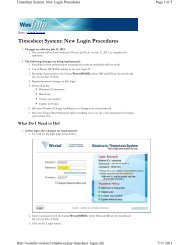The Addiction Behaviors Checklist: Validation of a New ... - Westat
The Addiction Behaviors Checklist: Validation of a New ... - Westat
The Addiction Behaviors Checklist: Validation of a New ... - Westat
You also want an ePaper? Increase the reach of your titles
YUMPU automatically turns print PDFs into web optimized ePapers that Google loves.
Vol. 32 No. 4 October 2006 <strong>Addiction</strong> <strong>Behaviors</strong> <strong>Checklist</strong>349assembled an assessment tool relying on behavioralobservations that are both logicallyconsistent with accepted definitions <strong>of</strong> opioidaddiction and relatively objective (the behavioris either present or not present).Importance <strong>of</strong> Specific <strong>Behaviors</strong>in <strong>Addiction</strong>Although there is general consensus regardingthe primary behaviors that make up addictionin chronic pain patients using opioids,there is as yet no diagnostic algorithm for compilingthese behaviors. In this context it is interestingto examine how individual ABC itemsrelate to expert global clinical judgments in orderto provide initial direction for the weighting<strong>of</strong> certain behaviors in the process <strong>of</strong>identifying addiction. <strong>The</strong> items that weremost frequently endorsed and most associatedwith the global clinical judgment included ‘‘difficultywith using medication agreement,’’ ‘‘increaseduse <strong>of</strong> narcotics (since last visit),’’‘‘used more narcotics than prescribed,’’ and‘‘patient indicated that s/he ‘needs’ or ‘musthave’ analgesic meds.’’ <strong>The</strong>se same behaviorshave been variously emphasized in the frameworks<strong>of</strong> Savage, 3 Chabal et al., 8 and Portenoyand Payne, 11 and were likely to also be endorsedon the PDUQ. 16 Further, each <strong>of</strong> thesebehaviors is consistent with consensus criteriafor addiction in pain patients. <strong>The</strong>se indicators<strong>of</strong> loss <strong>of</strong> control over opioid use and cravingfor opioids in chronic pain patients appear towarrant increased and/or emphasized concernin addiction assessment. Although the abovementioneditems could be considered forheavier weighting when assessing for behaviorscharacteristic <strong>of</strong> addiction, a weighting systemwas not incorporated into the current analysis.A future direction for the ABC would be to explorepossible weighting systems or further-developedscoring paradigms that might giveadded emphasis to more serious opioid misusebehaviors predictive <strong>of</strong> addiction.Since the ABC is a checklist, it may also be importantto include low-frequency items eventhough they did not display a significant bivariaterelationship with the global clinical judgmentin the current sample. An extremeexample <strong>of</strong> this is the item assessing if the patientbought medications on the street. This informationis very difficult to gather fromobservable behavior or the medical record andis usually only available from a patient reportor trusted collateral report. Though this itemshowed extremely low endorsement, we wouldargue that it should be left in the checklist sincea positive endorsement would be a clear warningsign to providers regarding continued prescription<strong>of</strong> opioid medications. Other itemsmight have low endorsement rates that are populationspecific. For example, the items regardingsignificant others’ concern about use <strong>of</strong>analgesics and receiving medications frommore than one provider also showed a low correlationwith the global clinical judgment inthis study. Both <strong>of</strong> these items had low endorsementrates, but this is hypothesized to be sampledependent. In the VA population, families arenot as frequently involved as in other settings,and the HMO nature <strong>of</strong> care and the computerizedpatient record effectively limit a patient’sability to receive opioid medications from multipleproviders. <strong>The</strong>se items may well be morefrequent and useful in other contexts.Another issue in the interpretation <strong>of</strong> an instrumentdesigned to track behaviors indicative<strong>of</strong> potential addiction is the concept <strong>of</strong>pseudoaddiction. 19e22 Pseudoaddiction includesbehaviors that are similar to addictionbut that are due to the undertreatment <strong>of</strong>pain. <strong>The</strong>refore, it is important to consider ifthe behaviors tracked with the ABC are indeedrepresentative <strong>of</strong> behaviors suggestive <strong>of</strong> addictionor due to the undertreatment <strong>of</strong> pain.Though it is an important theoretical consideration,the actual extent <strong>of</strong> pseudoaddiction hasnot been empirically validated. Within thechronic pain clinic at the Greater Los AngelesVeterans Affairs Healthcare System, physiciansand providers are cognizant <strong>of</strong> the iatrogenicissues involved in pseudoaddiction and arecareful to not make decisions regarding opioidmedication discontinuation or addiction basedsolely on patients’ requests or behaviors thatare due to an increased medication need dueto poorly controlled pain.Use <strong>of</strong> the ABCAlthough further validation and refinementis important, the current data suggest severalareas <strong>of</strong> utility for the ABC. It can be used clinically,as it was in this study, to track abuse behaviorsat clinic visits. Scores <strong>of</strong> 3 or aboveshould flag for more careful monitoring <strong>of</strong> patients,including more frequent urine screens







